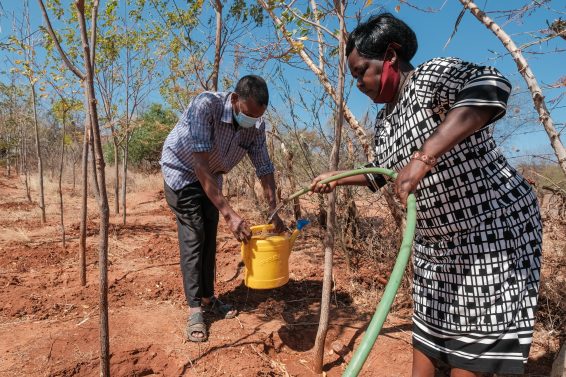3·2 billion people are affected by land degradation.
Economic growth trajectories pose even greater risks through destabilisation of the global commons—ie, the biosphere, climate, cryosphere, nutrient and water cycles, with people living in historically marginalised locations (eg, former colonies), especially people living in poverty, are particularly at risk.
Conflict and violence remain the main drivers of displacement and movements in sub-Saharan Africa in 2022, exacerbated by increasing climate shocks and hazards.
In fragile situations—whether induced by conflict, environmental disasters, or governance challenges—the decisions people make today about natural resources, such as trees, is shaping their future resilience.
The scientific evidence is clear: trees and forests contribute to community resilience. They provide ecosystem services to people at both plot and landscape scales. They also directly contribute to the soil’s ecological functioning and mitigate crop failure’s effects during droughts. However, despite the unmistakable evidence, the pathways to realise those benefits in vulnerable contexts is a lot more complex than building people’s capacity in planting trees. The knowledge and implementation gaps in tree-based resilience strategies are less about the technicalities but more about the social dynamics.
As part of the annual interdisciplinary conference on research in tropical and subtropical agriculture, natural resource management and rural development (Tropentag) conference, held in September this year, the panel, *Trees, People, and Choices in Fragile Situations*, brought together experts to discuss the complexities of integrating tree-based solutions into development and humanitarian efforts, particularly in fragile contexts.
“The challenge is to design and implement humanitarian and development programs that result in agricultural landscapes that harvest the ecosystem services of trees, agroforestry and crop-livestock integration,” explains Immaculate Edel, project manager of nutrition and food systems at the Center for International Forestry Research and World Agroforestry (CIFOR-ICRAF), as she introduces the panel. “The success of restoration programs often hinges on people’s choices.”
Rethinking resilience strategies
In fragile situations, where conflict, environmental stress and uncertainty prevail, research on people’s aspirations provides a crucial lens through which their needs and hopes for the future can be understood. Yet, “in these conditions, fragility tends to narrow the scope of aspirations, shifting from long-term visions of stability and resilience to immediate needs and urgency,” says Kai Mausch, senior economist at CIFOR-ICRAF. “In drylands, the cycle is stark: trees are cut for timber, firewood and charcoal, triggering a cascade of ecological loss—degraded soils, diminished productivity, and a spiral of poverty and conflict.”

Community members watering plants in Zombe, Kitui County – Kenya. Photo by Axel Fassio/CIFOR-ICRAF
Understanding how communities manage their land, particularly in relation to watersheds and farms, is primordial. It is not enough to consider isolated plots of land; these decisions must be seen as part of a larger, interconnected ecological system. This calls for nested program designs that can adapt and scale from the individual plot to the entire landscape.
“We cannot build resilience by working with individual households only”, says Alex Aweiti, agroecology lead at CIFOR-ICRAF, emphasizing the need for agricultural research and discussions to shift focus beyond plot-level interventions and embrace a broader, more integrated approach.
Asking communities to invest time and effort into restoration activities, such as planting and managing specific varieties of trees, requires people to have the confidence and the trust that they and their families will benefit from these activities in the future.
Restoration programs must start by rebuilding this trust and investing in landscape approaches that facilitate communication, based on mutual understanding of diverse actors, negotiation, and joint future planning and resource management decisions. “Hence, we need purpose-driven restoration programs,” underlines Michael Hauser, systems scientist at BOKU University and senior associate at CIFOR-ICRAF. “Restoration must go beyond measuring impacts such as the number of trees planted or hectares of land restored.”
Adopting nature-based solutions and ecological farming practices is not a simple, linear process where an individual farmer learns and implements a new technique. Instead, “decisions often involve negotiation and collaboration within households,” says Mary Crossland, livelihoods systems scientist at CIFOR-ICRAF.“In many places, women have limited influence over such decisions and often lack agency in many contexts. Understanding and addressing the dynamics of intra-household decision-making is crucial.”
By shifting from gender-responsive efforts to gender-transformative approaches, development practitioners can address the deeper root causes of inequality, ultimately leading to more equitable and sustainable farming practices programs.

A farmer and his family are looking to restore their land through agroforestry practices. Photo by Kelvin Trautman/CIFOR-ICRAF
Bridging knowledge gaps for resilience
Integrating local aspirations, research centred on decision-making and agroecological principles emerged as key components for building effective resilience strategies in vulnerable regions. By addressing the complexities of decision-making at multiple levels, the panellists highlighted the potential for tree-based solutions to contribute significantly to resilience. Understanding the decision-making processes behind program design, implementation and, ultimately, adoption would be crucial.
The panel concluded with a discussion about the pressing knowledge gaps and the future of research in tree-based resilience strategies. The speakers emphasized the need for more evidence on how different actors—governments, communities, and individuals—make decisions in fragile situations and how these decisions affect the success of nature-based solutions. The integration of aspirations, decision-focused research, and agroecological principles emerged as key components in developing effective resilience strategies in fragile contexts.
To address the complexities of decision-making at multiple levels, the panel identifies the need for more transdisciplinary research and programs, explicitly integrating the thirteen agroecology principles into humanitarian assistance. Partnerships between technical experts, governments, humanitarian agencies, and communities are crucial for successfully implementing resilience-building initiatives.
We want you to share Forests News content, which is licensed under Creative Commons Attribution-NonCommercial-ShareAlike 4.0 International (CC BY-NC-SA 4.0). This means you are free to redistribute our material for non-commercial purposes. All we ask is that you give Forests News appropriate credit and link to the original Forests News content, indicate if changes were made, and distribute your contributions under the same Creative Commons license. You must notify Forests News if you repost, reprint or reuse our materials by contacting forestsnews@cifor-icraf.org.
